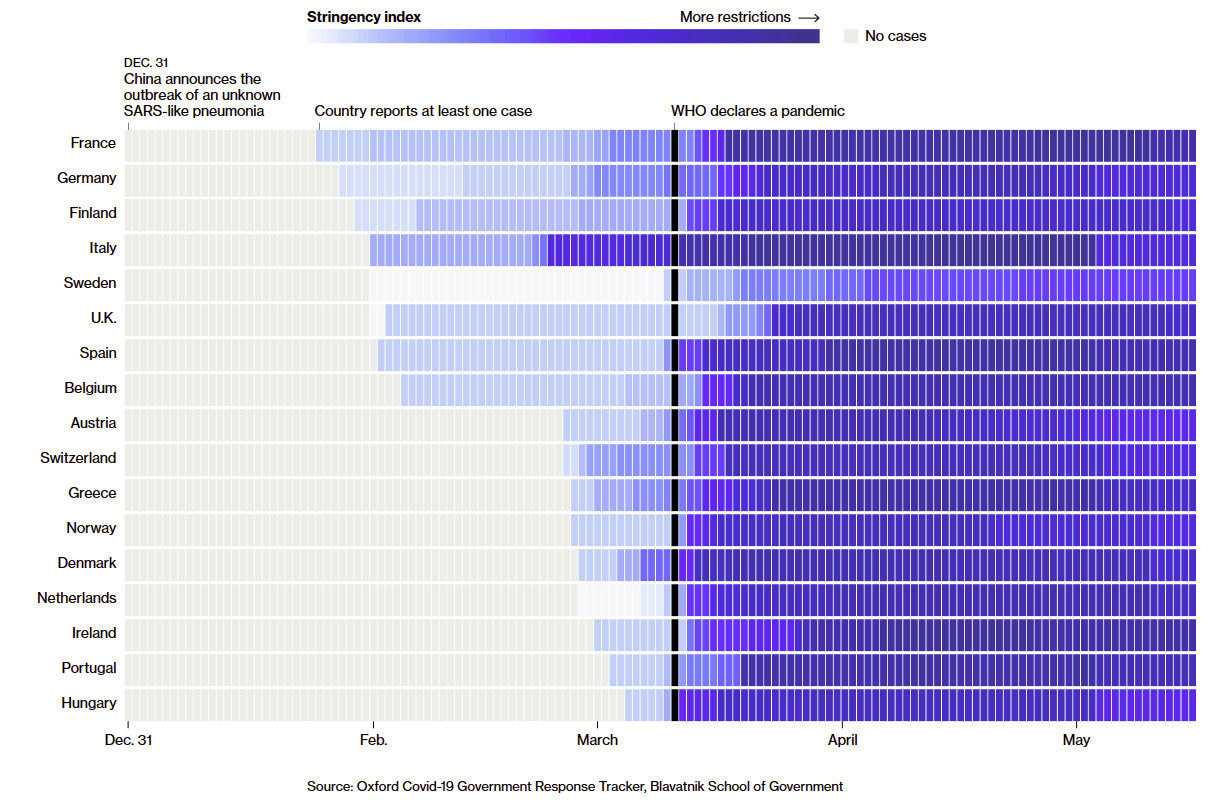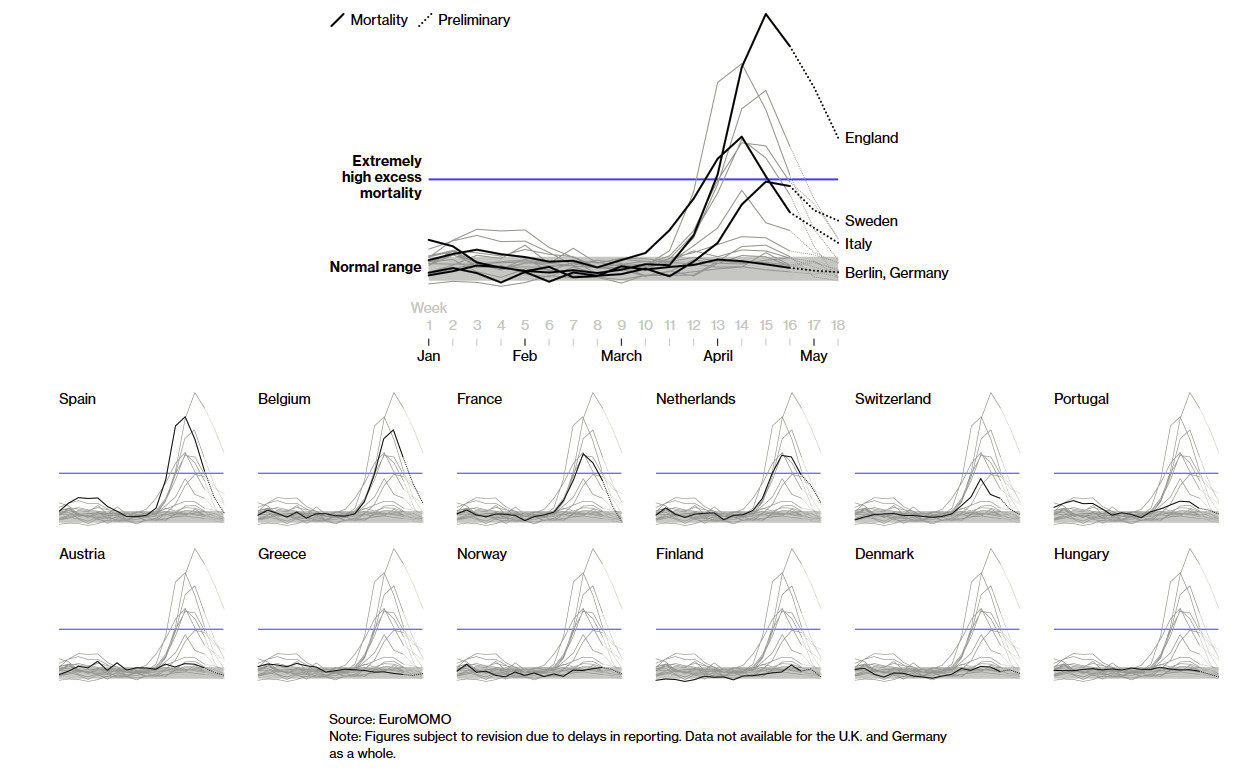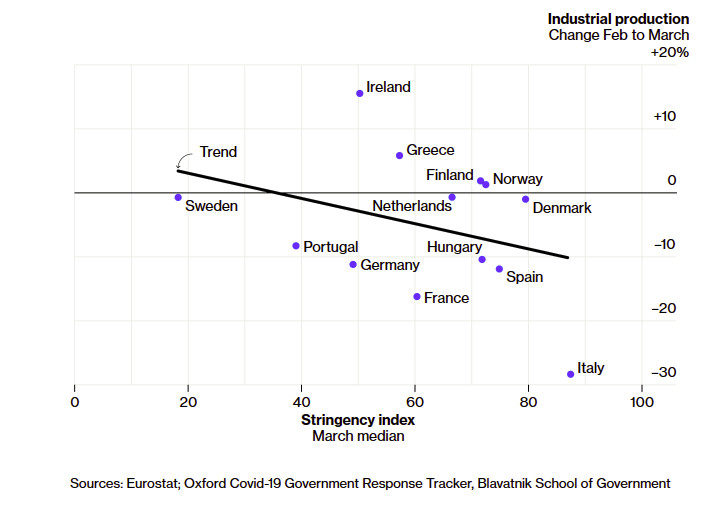The chart below shows the relative severity of Europe's restrictions based on work done by the University of Oxford's Blavatnik School of Government, which tracks a range of measures and scores how stringent they've been each step of the way.
Reaction Time
For many European countries, stringency levels increased substantially after the World Health Organization declared a pandemic, even when their case loads were low.
While not a gauge of whether the decisions taken were the right ones, nor of how strictly they were followed, the analysis gives a clear sense of each government's strategy for containing the virus. Some — above all Italy and Spain — enforced prolonged and strict lockdowns after infections took off. Others — especially Sweden — preferred a much more relaxed approach. Portugal and Greece chose to close down while cases were relatively low. France and the U.K. took longer before deciding to impose the most restrictive measures.
But, as our next chart shows, there's little correlation between the severity of a nation's restrictions and whether it managed to curb excess fatalities — a measure that looks at the overall number of deaths compared with normal trends.
Deadly Outcomes
Deaths above normal ranges shows the European countries that struggled to contain their Covid-19 outbreaks.
In Europe, roughly three groups of countries emerge in terms of fatalities. One group, including the U.K., the Netherlands and Spain, experienced extremely high excess mortality. Another, encompassing Sweden and Switzerland, suffered many more deaths than usual, but significantly less than the first group. Finally, there were countries where deaths remained within a normal range such as Greece and Germany.
Yet the data show that the relative strictness of a country's containment measures had little bearing on its membership in any of the three groups above. While Germany had milder restrictions than Italy, it has been much more successful in containing the virus.
The overall impression is that while restrictions on movement were seen as a necessary tool to halt the spread of the virus, when and how they were wielded was more important than their severity. Early preparation, and plentiful health-care resources, were enough for several countries to avoid draconian lockdowns. Germany, with better testing and contact tracing and more intensive care units than its neighbors, could afford to keep the economy a bit more open. Greece, by acting quickly and surely, appears to have avoided the worst, so far.
As one would expect, the countries with the most intense lockdowns look likely to suffer the most economically. What's not clear yet is how much economic benefit countries with relatively lax curbs really stand to gain, given the integrated and trade-driven nature of the European economy. The export-led Swedish economy is set to shrink 7% this year, its government said on Tuesday. Germany, whose economy was shrinking before the pandemic, is already in recession. These countries may bounce back earlier than others next year, but this is a painful moment for all.
The Economic Pain of Shutting Down
Early data show that countries with harsher responses to Covid-19 also suffered more economically.
The economic data for the lockdown period are only just appearing, and they may be revised substantially in the future given the obvious difficulties of collecting data during a pandemic. Regardless, what the past few months suggest is that the economic cost is not the only downside to a draconian lockdown. The Covid-19 experience has taught us that it's far better to respond quickly and smartly, with the right technology and mass testing and tracing, rather than only relying on the crudest of shutdowns. If there are second waves of the virus, we shouldn't repeat the mistakes of the first.
Ferdinando Giugliano and Lionel Laurent contributed reporting.
Notes: Stringency is a composite measure of government containment policies, ranging from 0 to 100. Indicators include closing of schools, workplaces and public transport, cancellations of public events, restrictions on gathering size, internal movement and international travel, requirements on staying at home and public information campaigns. The index doesn't provide information on how well policies are enforced, nor does it capture demographic or cultural characteristics that may affect the spread of Covid-19. Excess mortality is measured in z-scores, which is the standard deviation from the mean. A score of 2 and below indicates that deaths are within normal patterns observed for that period; above 15 is considered extremely high excess mortality.







But also many more people seeing through this game. Will we be able to stop it? I sure hope we will!!! Or it will be RUN TO THE WOODS and MOUNTAINS for our lives!!